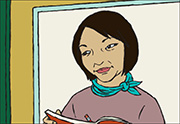What could Ms. Lin do to help her students learn to write persuasive essays?
Page 5: POW+TREE Applications
 Ms. Lin is eager to teach her students the POW+TREE strategy. She knows that a learning strategy is a plan that can help her students to improve their performance, learn new material, and be more aware of what they are trying to accomplish during an assignment. However, she also knows that it is not practical to assume that, without proper instruction, the strategy will achieve the desired outcome or even be used. Therefore, it is imperative that Ms. Lin use explicit instruction and teach her students when and how to use the POW+TREE strategy.
Ms. Lin is eager to teach her students the POW+TREE strategy. She knows that a learning strategy is a plan that can help her students to improve their performance, learn new material, and be more aware of what they are trying to accomplish during an assignment. However, she also knows that it is not practical to assume that, without proper instruction, the strategy will achieve the desired outcome or even be used. Therefore, it is imperative that Ms. Lin use explicit instruction and teach her students when and how to use the POW+TREE strategy.
Teaching POW+TREE
- It is presented in a step-by-step sequence.
- It has been empirically validated.
Ms. Lin will explicitly teach POW+TREE using the six steps of SRSD outlined in the table below. Click on the links in the table to view how Ms. Lin follows each step of the model.
Self-Regulated Strategy Development
 Before she teaches the POW+TREE strategy, Ms. Lin determines what skills her students will need in order to use it properly. If her students are unable to perform any of the skills she identifies, she knows that she will need to provide explicit instruction for those specific skills. The table below outlines the skills that Ms. Lin will assess.
Before she teaches the POW+TREE strategy, Ms. Lin determines what skills her students will need in order to use it properly. If her students are unable to perform any of the skills she identifies, she knows that she will need to provide explicit instruction for those specific skills. The table below outlines the skills that Ms. Lin will assess.
| Skill | Assessment | |
|
ick an idea or opinion. |
Given a prompting question (e.g., Should children go to school in the summer?), the student should be able to clearly decide what he or she believes. |
|
|
rganize and generate notes and ideas for each part of the TREE. |
Given a graphic organizer and information, the student should be able to appropriately fill in the organizer. |
|
 |
Topic Sentence |
Given a prompting question, the student should be able to clearly respond, writing what he or she believes. |
| Reason |
Given his or her topic sentence, the student should be able to provide a written reason to support the topic sentence. |
|
| Explanation |
Given his or her topic sentence and reasons to support that topic sentence, the student should be able to elaborate on those reasons. |
|
| Ending | Given his or her topic sentence, reasons to support that topic sentence, and elaborations, the student should be able to compose a statement summarizing the information in the paragraph | |
|
rite and say more. |
Given the information in a graphic organizer, the student should be able to construct a complete paragraph. |
|
Ms. Lin discusses with her students reasons why learning to write is important. She explains the benefits of using the POW+TREE strategy and how it will help students to improve their writing skills.
Below is the presentation that Ms. Lin gave to her class.

I wanted to talk to you about the writing we’ve done so far. I know sometimes writing can be a difficult thing to do. Let’s think about the essays you just wrote. Can someone explain why it would be important to write a persuasive paper?
[Students discuss.]
Right now your opinions are not as clear or persuasive as they could be. I have an idea about how we can make your opinions clearer in your writing. You know how you use tools in shop class to make your projects better? I have a tool for you to use in writing that will make your papers better. The tool is a strategy called POW+TREE. This strategy helps you remember the parts of a persuasive essay and helps you organize your ideas.
Ms. Lin thinks aloud to demonstrate the use of the POW+TREE strategy. In this way, she verbalizes her thought processes as she models the strategy (see below).

Okay, I’ve just gotten an assignment to write a persuasive essay. My topic is, “Should children share their toys with other children who do not have toys?” I know I will use the POW+TREE strategy to help me plan, organize, and write my essay. Okay, the “P” stands for “Pick my idea.” Well, I’ve already been given the idea, so I need to come up with my opinion about the topic. My opinion is that kids should share their toys with other children who do not have toys. Now what do I need to do? Let’s see, the next step in POW+TREE is “O” for “Organize my notes.” How should I organize my notes for a persuasive essay? I will use TREE…
 Memorizing the steps of the POW+TREE strategy is of the utmost importance. The ultimate goal is for students to be able to use the strategy fluently, as opposed to spending all of their cognitive resources remembering what each letter of the mnemonic represents.
Memorizing the steps of the POW+TREE strategy is of the utmost importance. The ultimate goal is for students to be able to use the strategy fluently, as opposed to spending all of their cognitive resources remembering what each letter of the mnemonic represents.
Ms. Lin uses several activities to help her students to memorize the strategy. Below are two of these activities.
Hacky Sack Toss — Ms. Lin tells her students that when she tosses the hacky sack to them they should state a step in the POW+TREE strategy and tell what they need to do at that step. She starts by tossing a hacky sack to a student and asking, “What is the first step in the POW+TREE strategy?” The student responds, “Pick my idea. I need to decide what my opinion is.” The student then tosses the hacky sack back to Ms. Lin, tosses it to another student and asks for the next step.
Partner Sharing — After Ms. Lin provides training on partner sharing or paired instruction, she partners the students. Students take turns recalling the steps of the strategy and what they need to do at each step. Students use a mnemonic chart or cue cards to make sure their partners get each step correct. Partners give feedback to each other, and the process allows the pairs to repractice the steps correctly. This is especially helpful for students who struggle with memorization.
 Supporting the student is possibly the most critical part of the process. Students need to be given adequate time and support to master the strategy. In this stage, Ms. Lin uses scaffolding, which provides the structure that students need to learn how to effectively use a strategy. Over time, she will gradually reduce the amount of support she offers. It is important to remember, however, that even when students have learned the purpose of a strategy and have memorized its steps, they may not be ready to use the strategy independently.
Supporting the student is possibly the most critical part of the process. Students need to be given adequate time and support to master the strategy. In this stage, Ms. Lin uses scaffolding, which provides the structure that students need to learn how to effectively use a strategy. Over time, she will gradually reduce the amount of support she offers. It is important to remember, however, that even when students have learned the purpose of a strategy and have memorized its steps, they may not be ready to use the strategy independently.
Here is how Ms. Lin uses scaffolding as she teaches the POW+TREE strategy: Ms. Lin hangs a poster that displays the steps for the POW+TREE strategy to serve as a prompt for her students. Once the students have memorized the steps of the strategy, she will remove the poster and ask her students to make cue cards without the strategy descriptions. Eventually, she will have her students stop using the cue cards altogether. At this point, most of her students will have attained mastery of the strategy and will be able to work independently. She will continue to prompt them to use the strategy throughout the year.
 During the independent practice stage, most of Ms. Lin’s students will demonstrate mastery of the POW+TREE strategy and will be able to write persuasive essays independently. Ms. Lin knows that the students will need ongoing opportunities to practice the strategy. She will monitor her students’ use of the strategy and will evaluate whether or not their performance has improved.
During the independent practice stage, most of Ms. Lin’s students will demonstrate mastery of the POW+TREE strategy and will be able to write persuasive essays independently. Ms. Lin knows that the students will need ongoing opportunities to practice the strategy. She will monitor her students’ use of the strategy and will evaluate whether or not their performance has improved.
Along the way, she asks herself the following questions:
- Are the students actually using the strategy?
- Has their writing performance improved?
- Do the students see the strategy as valuable?
- Can they use the strategy in other persuasive writing assignments?
To promote generalization, Ms. Lin encourages her students to use the strategy in other content areas (e.g., social studies) for which they are required to write persuasive text.
| Strategy | Activity | ||
|
|
|||
|
Malcolm’s Ideas
(Close this panel) |
|||
|
rganize and generate notes and ideas for each part of the TREE. |
|||
 |
Topic Sentence | Click to view Malcolm’s graphic organizer. | |
| Reason | |||
| Explanation | |||
| Ending | |||
|
Malcolm’s Graphic Organizer
(Close this panel) |
|||
|
rite and say more. |
|||
|
Malcolm’s first writing draft
(Close this panel) |
|||
When Malcolm has used the POW+TREE strategy to write his essay, Ms. Lin asks him to review his writing for completeness. Later, she provides Malcolm with edit-and-revision recommendations about his first draft.
Ms. Lin’s Edits

(Close this panel)
Malcolm’s second draft

(Close this panel)
When Malcolm and the other students have completed the second draft of their essays, Ms. Lin implements the peer-editing process. After this, the students write the final versions of their essays.







